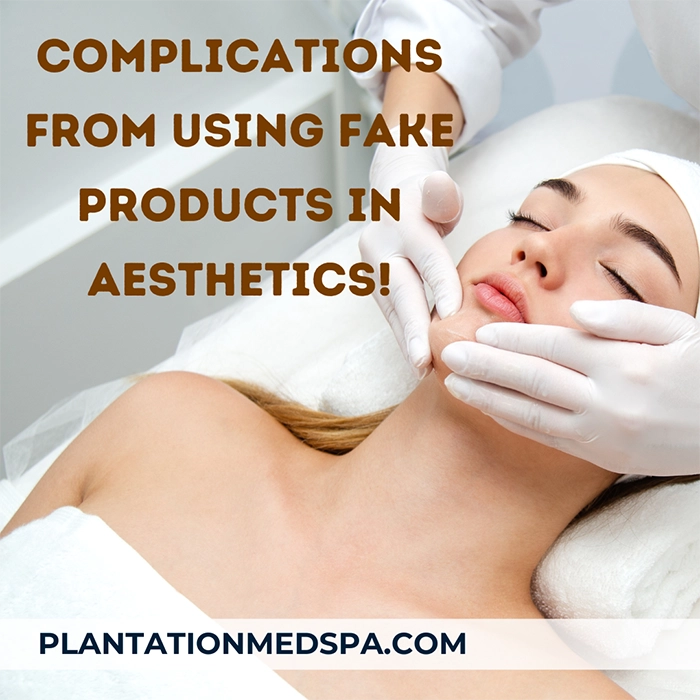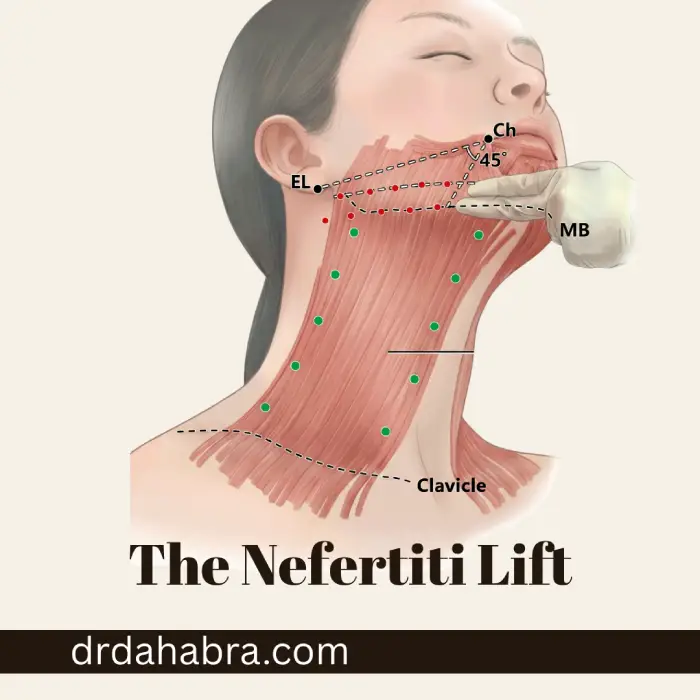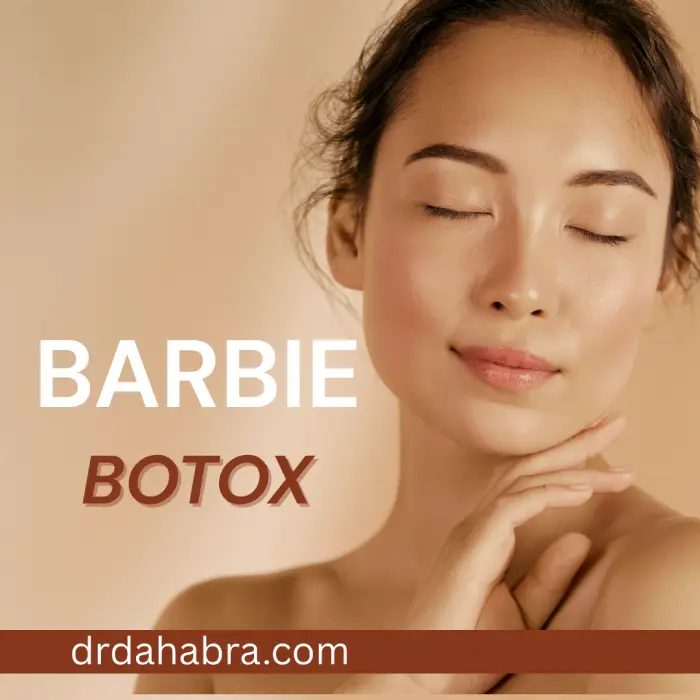The Dangers of Using Fake Aesthetic Products: Avoid Costly Mistakes
Complications from Using Fake Products in Aesthetics
Aesthetic treatments have skyrocketed in popularity, making people eager to achieve perfect skin and facial harmony. This article talks about the complications from using fake products in aesthetics.
However, with this demand comes a dark undercurrent: fake aesthetic products. These counterfeit products range from facial fillers to skincare treatments and promise the same benefits at a fraction of the price. But these bargains often come with grave risks.
Fake aesthetic products can look almost identical to legitimate items, but their composition often includes unsafe or unregulated substances. Consumers looking for deals may need to be made aware of the harm these products can cause.
With unproven ingredients and zero quality control, these counterfeit products pose severe threats to your skin and overall health.
Understanding how fake aesthetic products infiltrate the market, their potential dangers, and how to avoid them is essential for anyone considering an aesthetic procedure.
Before taking a risk, knowing what’s at stake is critical—your appearance, health, and wallet.
Table of Contents
1. How Fake Aesthetic Products Infiltrate the Market
2. Common Types of Fake Products in Aesthetics
3. The Health Risks of Using Fake Aesthetic Products
4. Allergic Reactions and Skin Infections
5. Botched Results from Fake Injectables
6. Long-Term Health Consequences
7. The Psychological Impact of Using Fake Aesthetic Products
8. How to Spot Fake Aesthetic Products: Key Warning Signs
9. The Role of Unlicensed Practitioners
10. Financial Implications of Fake Aesthetic Products
11. Legal Consequences of Using Counterfeit Aesthetic Products
12. Steps to Take If You Suspect You’ve Been Treated with Fake Products
13. How to Ensure You’re Using Genuine Aesthetic Products
14. The Importance of Choosing Certified Professionals for Aesthetic Procedures
15. Frequently Asked Questions (FAQs)
16. Conclusion: Complications from Using Fake Products in Aesthetics
17. References
1. How Fake Aesthetic Products Infiltrate the Market
The counterfeit beauty market is booming, driven by the high demand for aesthetic treatments.
Fake products make their way to consumers through unregulated online sellers. Many websites and social media pages promise cheaper alternatives to famous brands but often sell fraudulent items. These products can look identical to the originals, making them difficult to spot.
Another entry point for fake products is through rogue practitioners. These individuals claim to be professionals but are not certified or qualified. They often purchase these fake products at a lower cost, maximizing their profit while putting the patient at serious risk.
As a result, individuals seeking beauty treatments may unknowingly receive substandard or unsafe products.
Furthermore, counterfeit products sometimes enter reputable-looking beauty clinics or salons. Even legitimate establishments can fall victim to sourcing their products from dubious suppliers, leading to unintentional harm to their customers.
Consumers must do thorough research and ask questions about the products used.
2. Common Types of Fake Products in Aesthetics
Not all fake aesthetic products are the same. Some commonly counterfeited items include Botox, dermal fillers, and skincare products like anti-aging creams. Botox, a popular treatment for smoothing wrinkles, is frequently faked due to its high demand.
However, counterfeit Botox can be filled with harmful substances that don’t follow the same strict regulations as genuine products.
Fake dermal fillers are another concern. These products, designed to enhance volume or shape in areas like the lips and cheeks, are often made with cheap, dangerous materials.
Instead of the approved hyaluronic acid, counterfeit fillers may contain:
- Silicone or other non-biocompatible substances.
- Leading to complications such as infections.
- Nodules.
- Permanent tissue damage.
Even luxury skincare products like creams and serums are commonly faked. These items promise anti-aging or skin-brightening benefits but instead may cause adverse reactions like rashes, burns, or acne breakouts.
Identifying fake aesthetic products, no matter their category, is challenging for an untrained eye, making it easier for them to increase.
3. The Health Risks of Using Fake Aesthetic Products
One of the most alarming aspects of fake aesthetic products is the health risks they pose. These products are often made in unsanitary conditions without oversight, leading to contamination.
Using these items in any treatment can result in bacterial infections, which can cause pain, swelling, and even disfigurement.
Another health risk comes from the harmful chemicals used in counterfeit products. Many fake dermal fillers, for instance, contain toxic ingredients not approved for use in humans.
These can trigger allergic reactions, leading to severe side effects such as anaphylactic shock, difficulty breathing, and hospitalization.
Additionally, fake aesthetic products may not degrade properly in the body. Natural dermal fillers are designed to be absorbed over time, but counterfeit versions can stay lodged in tissues, creating lumps, irregularities, and sometimes even requiring surgical removal.
These serious health risks are not worth the savings on a counterfeit product.
4. Allergic Reactions and Skin Infections
Allergic reactions are one of the most common side effects of fake aesthetic products.
Since these items are often produced with inferior and untested ingredients, the chances of an allergic reaction increase significantly. Many consumers experience redness, swelling, and irritation immediately after treatment with counterfeit products.
In more severe cases, fake products can lead to painful and dangerous infections. Without proper sanitation during production, these products may be contaminated with bacteria or other pathogens.
Once applied to the skin or injected into the body, these contaminants can cause cellulitis or abscesses, requiring medical intervention.
The risk of infection is incredibly high when counterfeit injectables are used. Since these fake fillers or Botox substitutes are introduced directly into the skin, they can introduce bacteria deep into tissues.
If left untreated, these infections can lead to scarring, tissue death, or even systemic infection, requiring hospitalization.
5. Botched Results from Fake Injectables
Fake injectables, such as counterfeit Botox or fillers, often result in unsatisfactory or botched results, leaving patients with uneven, unnatural appearances.
Counterfeit injectables may contain ingredients that cause swelling, lumps, or skin irregularities, unlike legitimate products formulated to provide controlled, precise results. For instance, fake Botox may paralyze unintended facial muscles, leading to drooping eyelids, asymmetry, or a “frozen” expression that can take months to resolve.
Additionally, these botched results may need to be corrected. Sometimes, the damage caused by fake fillers is irreversible without surgical intervention. While licensed practitioners using legitimate products have predictable outcomes based on clinical studies, those using counterfeit items may experience complications that range from minor irregularities to significant facial distortion.
The time and cost required to fix these botched results can far exceed the original treatment’s price.
Beyond the physical consequences, botched results can have a significant emotional impact. Patients who undergo aesthetic treatments often do so to feel more confident in their appearance.
However, when the outcome is worse than expected, it can lead to frustration, anxiety, and regret. Trusting a certified professional and ensuring the products’ authenticity can prevent these heartbreaking outcomes.
6. Long-Term Health Consequences
The long-term health consequences of using fake aesthetic products can be severe and may not manifest immediately after treatment. Fake fillers, for example, may include ingredients that are not biocompatible, meaning they don’t dissolve naturally over time as genuine fillers do.
This can lead to the formation of hard lumps or granulomas beneath the skin, which can be painful and disfiguring. These masses may sometimes require surgical removal, leaving scars or permanent damage.
In addition to physical deformities, some counterfeit products contain toxic substances that may pose serious health risks over time. Prolonged exposure to harmful chemicals can lead to tissue death, nerve damage, or even more systemic issues like organ failure if the product migrates or enters the bloodstream.
Patients often overlook these risks, focusing instead on the immediate benefits or the cost savings of cheaper, fake alternatives.
Moreover, the psychological toll of dealing with long-term health problems can be significant. Chronic pain, scarring, or disfigurement can affect a person’s self-esteem and mental well-being.
Rather than facing years of corrective procedures and regret, it’s crucial to prioritize safety by selecting only certified providers and verified, genuine aesthetic products.
7. The Psychological Impact of Using Fake Aesthetic Products
The psychological impact of using fake aesthetic products can be profound and long-lasting. For many individuals, aesthetic treatments are a form of self-care to boost self-esteem and enhance personal confidence.
However, when these treatments go wrong due to fake products, the emotional distress can be overwhelming. Patients may feel ashamed, frustrated, or betrayed after trusting in a procedure that damages their appearance.
In more severe cases, individuals may experience anxiety, depression, or even social withdrawal. The anticipation of looking better, only to end up with botched results, can severely damage one’s mental health.
The visible signs of a failed treatment—whether it’s facial asymmetry, infections, or scarring—can act as constant reminders of the ordeal, leading to diminished self-worth.
Furthermore, the process of correcting these errors can be emotionally exhausting. Not only does it involve financial strain, but the time, effort, and additional treatments required to fix the damage can take a significant mental toll.
This is why it’s critical to avoid fake aesthetic products and rely on trusted professionals who use authentic, safe products to ensure peace of mind and a positive outcome.
8. How to Spot Fake Aesthetic Products: Key Warning Signs
Spotting fake aesthetic products can be challenging, but there are key warning signs that savvy consumers should watch out for.
First, always be cautious of products sold at meager prices. While it may be tempting to choose a cheaper option, steep discounts often signal counterfeit goods.
Genuine Botox, fillers, and skin care products have fixed costs that reflect the research, testing, and safety measures behind them.
Another red flag is unfamiliar packaging. If the packaging of an aesthetic product seems off—whether it’s due to misspelled labels, inconsistent branding, or low-quality materials—it’s likely a fake. Legitimate products are usually packaged meticulously, with clear instructions and information from trusted manufacturers.
Constantly scrutinize the packaging and ask your provider for proof of authenticity.
Additionally, be wary of who is administering the treatment. Unlicensed practitioners are often the culprits behind fake products. These individuals may lack proper certifications or training, making them more likely to use counterfeit items to cut costs.
Always verify the credentials of your aesthetic provider to ensure you’re receiving both genuine products and professional care.
9. The Role of Unlicensed Practitioners
Unlicensed practitioners play a significant role in the spread of fake aesthetic products.
These individuals are not legally allowed to administer aesthetic treatments, but they often operate in unofficial or underground settings where regulations are easily skirted. To maximize their profit, they may purchase fake or lower-quality products from unregulated suppliers, putting their clients at serious risk.
With the proper training, unlicensed practitioners are likely to use counterfeit products, but they may also need to gain the knowledge to administer them safely. Botox and dermal fillers require precise techniques to achieve the desired results without causing harm.
An unlicensed provider might inject the product too deeply, in the wrong area, or in incorrect doses, which can lead to complications like infections, tissue damage, or even nerve paralysis.
Choosing a certified and licensed practitioner is essential for ensuring that the treatments are performed correctly and that the products used are genuine. Licensed professionals adhere to strict standards and only use products vetted for safety and efficacy.
Investing in quality care from a qualified expert is always better regarding your health and appearance.
10. Financial Implications of Fake Aesthetic Products
The financial implications of using fake aesthetic products can be staggering beyond the initial savings on the counterfeit item.
While fake products are often sold at lower prices, the cost of correcting complications can add up quickly. Botched results may require multiple corrective treatments, ranging from medical interventions to surgical procedures, each with its price tag.
In addition to medical costs, patients may lose money due to time off work, particularly if complications lead to long-term recovery or repeated visits to a medical professional.
Insurance often does not cover Corrective surgeries or treatments, further adding to the financial burden. What seemed like an affordable beauty fix can ultimately drain savings, causing financial stress alongside the physical and emotional toll.
Moreover, the psychological impact of poor results may lead individuals to seek additional treatments to restore their self-confidence, leading to more expenses.
In the long run, investing in legitimate aesthetic products and certified professionals is much safer and cost-effective, ensuring satisfying results and peace of mind.
11. Legal Consequences of Using Counterfeit Aesthetic Products
Using or distributing fake aesthetic products carries significant legal consequences for practitioners and consumers.
In many regions, administering counterfeit products is illegal and can result in severe penalties, including fines, license suspension, or imprisonment for practitioners.
Consumers who unknowingly use counterfeit products may also find themselves embroiled in legal battles, especially if the product causes severe harm and they seek compensation.
There’s also the risk of being implicated in criminal investigations. Law enforcement agencies worldwide are cracking down on counterfeit product rings, targeting the manufacturers and distributors of fake items.
Patients who willingly engage with unlicensed practitioners may be at risk if these illegal activities are uncovered.
Furthermore, legal actions could follow if someone suffers harm from counterfeit products. Lawsuits for damages can be filed against both the provider and the seller of the fake products, leading to costly legal battles.
Staying on the right side of the law by using legitimate products and certified professionals is not just an intelligent health decision—it’s also a way to avoid potential legal headaches.
12. Steps to Take If You Suspect You’ve Been Treated with Fake Products
If you suspect you’ve been treated with fake aesthetic products, acting quickly to minimize potential harm is essential.
The first step is to consult with a licensed healthcare professional or dermatologist who can assess the situation and confirm whether a counterfeit product was used. They may recommend diagnostic tests or physical exams to identify immediate risks, such as infection or tissue damage.
Next, document everything related to your treatment, including the name of the product used, the practitioner, and any symptoms or complications you’re experiencing. This information will be vital if you pursue legal action or file a complaint with health authorities.
Reporting the practitioner to medical boards or local authorities can help prevent future victims from undergoing similar experiences.
Finally, follow your healthcare provider’s recommendations for corrective treatments. In some cases, fake fillers may need to be dissolved or surgically removed.
Other times, it’s a matter of addressing complications like infections or scarring. Taking swift action will improve your chances of a full recovery and help mitigate any long-term consequences.
13. How to Ensure You’re Using Genuine Aesthetic Products
Ensuring the authenticity of aesthetic products begins with choosing a certified, reputable provider. Licensed practitioners must use products that meet regulatory standards, giving you peace of mind that the treatments are safe and effective.
Before undergoing any procedure, ask your provider about their brands and products. Request to see packaging and documentation that verifies the product’s authenticity.
Purchasing aesthetic products from authorized distributors is another way to avoid counterfeit items. Legitimate distributors work directly with manufacturers and follow strict quality controls.
If you’re buying skincare products or at-home treatments, avoid unknown online sellers and third-party websites selling fake versions of popular items.
Lastly, researching the product brand and its approved uses can further protect you. Regulatory agencies like the FDA or the European Medicines Agency (EMA) approve most legitimate aesthetic products.
Checking the manufacturer’s website for a list of authorized providers and distributors ensures you get the real deal and avoid counterfeit risks.
14. The Importance of Choosing Certified Professionals for Aesthetic Procedures
When it comes to aesthetic procedures, choosing a certified professional is critical to ensuring your safety and the quality of your results.
Certified practitioners have undergone rigorous training, ensuring they are knowledgeable about facial anatomy, injection techniques, and product safety. This expertise helps minimize the risks of complications and ensures you receive the best possible care.
Certified professionals are also required to use only genuine products from reputable sources. This means you can trust that the Botox or fillers are authentic and have passed necessary safety tests.
In contrast, unlicensed practitioners may cut corners using fake or substandard products, which can lead to disastrous results.
Furthermore, certified practitioners are held to a code of ethics and professional standards. They are accountable to medical boards and other regulatory bodies, ensuring they follow best practices.
By choosing a certified professional for your aesthetic procedures, you protect yourself from the risks of counterfeit products and unqualified providers.
15. FAQs About Complications from Using Fake Aesthetic Products
Q1. What are the risks of using fake Botox?
Concise Answer: Fake Botox can cause severe health complications and unsatisfactory aesthetic results.
Detailed Answer: Fake Botox can lead to uneven or unnatural facial expressions, such as drooping eyelids or asymmetric features. This happens because counterfeit products often contain incorrect formulations, which can cause paralysis in unintended muscles.
Moreover, fake Botox may be made with harmful ingredients, leading to serious health risks like infections, allergic reactions, and, in severe cases, systemic problems such as breathing difficulties or long-term nerve damage.
Q2. How can I tell if an aesthetic product is fake?
Concise Answer: Fake aesthetic products are often identified by their low price, poor packaging, and unauthorized sellers.
Detailed Answer: One of the easiest ways to spot a fake aesthetic product is through its price—if it’s too good to be true, it probably is. Fake products often have substandard or suspicious packaging with errors in labeling, misspelled words, or inconsistent branding.
Always buy from certified distributors or providers, and verify the product with the manufacturer if unsure. Ensuring your practitioner is licensed also reduces the risk of being treated with counterfeit products.
Q3. What are the consequences of using fake dermal fillers?
Concise Answer: Fake dermal fillers can cause infections and disfigurement and may require surgical correction.
Detailed Answer: Using fake dermal fillers can result in severe skin complications like infections, abscesses, and even tissue death. Because counterfeit fillers are often made from unapproved materials, they can form lumps, nodules, or irregularities under the skin, causing an unnatural appearance.
In the worst cases, these fake fillers may need to be surgically removed, which can leave scars and lead to permanent disfigurement, not to mention the psychological and financial toll.
Q4. Can fake aesthetic products cause permanent damage?
Concise Answer: Yes, fake aesthetic products can lead to permanent scarring, disfigurement, and tissue damage.
Detailed Answer: Fake products often contain non-biocompatible ingredients that don’t dissolve or degrade appropriately in the body, leading to permanent lumps or irregularities in the treated areas.
In severe cases, the damage can extend beyond cosmetic concerns to include nerve damage, chronic pain, or even tissue necrosis (death), which can result in lifelong disfigurement and require invasive treatments to correct.
Q5. Why do unlicensed practitioners use fake products?
Concise Answer: Unlicensed practitioners often use fake products to cut costs and maximize profits.
Detailed Answer: Unlicensed practitioners typically operate in a gray market area, where they aren’t bound by the same regulations as certified professionals. To keep their overhead low, they may purchase counterfeit products that are cheaper than legitimate versions.
These practitioners may also lack the proper training to recognize or adequately administer actual aesthetic products, leading to dangerous outcomes for the patients they treat.
Q6. What should I do if I think I’ve been treated with a fake product?
Concise Answer: Consult a licensed medical professional immediately for assessment and corrective action.
Detailed Answer: If you suspect you’ve been treated with a fake aesthetic product, the first thing to do is seek medical attention.
A qualified healthcare provider can assess the damage, run tests to confirm the product’s authenticity, and suggest corrective procedures, such as dissolving fake fillers or treating infections.
It’s also important to document your symptoms and the treatment you received so that you can report the practitioner or supplier to the relevant authorities for further investigation.
Q7. Can fake skincare products be dangerous?
Concise Answer: Fake skincare products can cause severe skin reactions and long-term damage.
Detailed Answer: Fake skincare products are often made with unregulated ingredients that can cause allergic reactions, irritation, or chemical burns. These products may contain harmful chemicals that aren’t safe for use on the skin, and prolonged use can result in skin damage, hyperpigmentation, or even permanent scarring.
Always purchase skincare products from trusted, authorized retailers to ensure you use safe and effective products.
Q8. Are fake aesthetic products common?
Concise Answer: Fake aesthetic products are widespread, especially in unregulated markets and online platforms.
Detailed Answer: With the rise of online shopping and social media-based sales, fake aesthetic products have become increasingly common. These products are often sold at lower prices and may be difficult to distinguish from the real thing at first glance.
Unscrupulous sellers and unlicensed practitioners often source counterfeit Botox, fillers, and skin care products, making it essential for consumers to be vigilant and only purchase from certified providers and authorized distributors.
Q9. How can I find a qualified professional for aesthetic treatments?
Concise Answer: Look for a licensed, board-certified practitioner with verified credentials.
Detailed Answer: To ensure safe and effective treatment, choosing a licensed professional with verified credentials is crucial—research practitioners’ qualifications, reviews, and experience in the treatment you’re considering.
You can also check if they are members of recognized medical boards or associations related to cosmetic procedures. A certified professional will always use genuine, regulated products and follow safety protocols to minimize risk.
Q10. Are there any legal risks associated with using fake aesthetic products?
Concise Answer: Using or distributing fake aesthetic products can lead to legal consequences.
Detailed Answer: Using fake aesthetic products is illegal in many places, and individuals who distribute or use them can face significant legal penalties, including fines or imprisonment.
Patients may also be drawn into legal battles if they suffer harm and seek compensation through lawsuits. Counterfeit product practitioners risk losing their licenses and could be prosecuted for violating medical regulations.
Q11. What are the signs of infection after using fake fillers?
Concise Answer: Signs of infection include redness, swelling, pain, and pus around the injection site.
Detailed Answer: Infections caused by fake fillers often present as swelling, redness, and increased pain at the injection site. You may also notice warmth in the area, pus, or fever, indicating the body is fighting an infection.
Infections from fake products can be dangerous, requiring antibiotics or surgical drainage, so it’s crucial to seek medical help immediately if you notice these symptoms.
Q12. What is the difference between fake and expired aesthetic products?
Concise Answer: Fake products are counterfeit, while expired products are genuine but no longer safe.
Detailed Answer: Fake products are intentionally made to mimic legitimate ones but often contain dangerous or unregulated ingredients.
On the other hand, expired products were once genuine but were past their recommended usage date, meaning they may have lost their efficacy or become unsafe due to degradation.
Both can pose health risks, but fake products carry a higher chance of containing harmful chemicals or contaminants.
Q13. How long do the effects of fake Botox or fillers last?
Concise Answer: The effects of fake Botox or fillers can be unpredictable and dangerous.
Detailed Answer: The duration and outcome of fake Botox or fillers vary widely, depending on their ingredients. Some counterfeit products may break down faster than legitimate ones, leading to short-lived and unsatisfactory results.
In contrast, others may linger in the body longer than expected, potentially causing long-term complications. In some cases, fake products may never break down properly and require surgical removal.
Q14. Can I reverse the effects of fake aesthetic products?
Concise Answer: Some fake products can be dissolved, but severe cases may require surgery.
Detailed Answer: Depending on the type of fake product used, some may be dissolved by injecting substances like hyaluronidase for fake fillers made with hyaluronic acid.
However, if the product contains unapproved or unsafe materials, more invasive procedures like surgery may be necessary to remove it. Immediate consultation with a medical professional is critical to determine the best action for reversal or correction.
Q15. What are the safest ways to avoid complications from aesthetic treatments?
Concise Answer: Choose licensed practitioners and ensure they use genuine, regulated products.
Detailed Answer: To avoid complications from aesthetic treatments, always seek out licensed and certified practitioners who have a proven track record. Ask about the products they use, verify that they are FDA-approved or meet the necessary regulations, and ensure they are sourced from reputable manufacturers.
Avoid unregulated, at-home treatments or products purchased online from unknown sellers, as these are more likely to be counterfeit and dangerous.
16. Conclusion
The use of fake aesthetic products poses severe risks to both your appearance and your health. From botched results like facial asymmetry and unnatural appearances to severe health complications such as infections, allergic reactions, and even permanent tissue damage, counterfeit beauty products are never worth the initial savings they promise.
These products, often administered by unlicensed practitioners or sold through dubious channels, can leave lasting physical and psychological scars, making corrective treatments and even surgery necessary.
Beyond the immediate health risks, the long-term financial and legal consequences of using fake aesthetic products cannot be ignored. The cost of correcting botched procedures can far exceed the price of choosing legitimate treatments from certified professionals in the first place.
Additionally, involvement with illegal or counterfeit products could lead to legal repercussions for the practitioner and the patient. By understanding these risks, consumers can make informed decisions prioritizing their well-being over short-term gains.
Ultimately, protecting yourself means investing in quality care. Always seek out licensed professionals and ensure that only authentic, FDA-approved products are used in your treatments.
Doing so safeguards your health and increases the likelihood of achieving the beautiful, natural results you desire without the dangers of fake products.
We have covered everything about the complications from using fake products in aesthetics.
Transform Your Look with the Different Licensed Treatments Products at Plantation Med Spa
Experience the revolutionary power of licensed treatment products at Plantation Med Spa, Florida. Our state-of-the-art treatments revitalize and rejuvenate, offering you a path to radiant, youthful skin. Why wait to unlock your best self?
Call us now at (954) 595-2607 or book online. Your journey to flawless skin begins with just a click or a call.
Embrace the beauty, embrace innovation – Embrace You.
17. References
- Dr. Chadi Dahabra
- Plantation Med Spa
- West Palm Beach Med Spa
- Beverly Hills Wellness Center & Med Spa
- Botulinum Toxin in Aesthetic Medicine (book)
- Safety of Botulinum Toxin in Aesthetic Medicine
- Adverse Reactions to Dermal Fillers: Review
- Understanding, Avoiding, and Managing Dermal Filler Complications
- Adverse Events Associated With Aesthetic Dermal Fillers: A 10-Year Retrospective Study of FDA Data
- Systemic Allergic Reactions to Corticosteroids
- Adverse reactions to injectable soft tissue fillers
- Adverse Reactions to Injectable Soft Tissue Permanent Fillers
- Facial skin and soft tissue infection caused by Mycobacterium wolinskyi associated with cosmetic procedures
- Cosmeceuticals: undefined, unclassified, and unregulated




